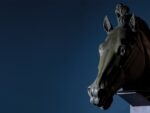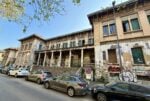Jan Vercuysse – The Presence of Absence
.jpg)
In mostra da Vistamare a Pescara opere dagli anni ‘80 al 2010 che si dispiegano con cadenza non cronologica ma tematica, attraverso una narrazione fotografica, e raccontano la ricerca di Vercruysse per immagini.
Comunicato stampa
JAN VERCRUYSSE
The Presence of Absence
Vistamare, Pescara
Opening March 23 2019, 7 - 9pm
March - September 2019
Vistamarestudio, Milano
Opening March 27 2019, 7 - 9 pm
March - June 2019
Vistamare and Vistamarestudio are pleased to present The Presence of Absence, a single exhibition straddling two venues, Pescara and Milan, in tribute to the Belgian artist Jan Vercruysse, who passed away last year.
The investigation of Jan Vercuysse was focused on the spiritual nature of art and on the idea that art acquires a value entirely detached from that of reality, finding its raison d’être in a deliberate “artificiality”.
As a student he wrote poems, and start to consider the artworks as words in a discourse, capable of generating a form of visual poetry. He worked in “cycles”, the most important of which are Chambres, Tombeaux and Places, which, like the lines of a sonnet, construct an ineluctable question: what is the role of art and the artist today? The void, or emptiness, becomes a feature of his work in the series entitled Atopie – non-places that have no need to relate to reality and which find their most perfect expression in non-being.
Opening on March 23, the exhibition at Vistamare in Pescara features works from the 1980s to 2010, organized thematically rather than chronologically and presented in the form of a photographic narrative/narrationof Vercruysse’s research, narrated in images.
First presented in Italy as part of a solo exhibition at the Castello di Rivoli in 1992, his Tombeaux, 1987-1994, often take the form of monumental sculptures in wood, bronze and glass. The ambiguity of the French title – which refers to both a tomb or gravestone and a form of musical or poetic elegy – reflects the combination of gravity and playfulness that was one element of Vercruysse’s poetics. Occupying the central room of the gallery, Les Paroles [Letto], 1998-2001, are three lectern-shaped structures in painted wood, combining flatness and volume, and opening out to hold musical scores imprinted on sheets of glass.
Places is a series on which Vercruysse began to work in 2005: the title itself indicates the underlying idea of places favoured by memory, where the meaning of past events and fragments of human life collect and linger. The artist molds a new form of language in which the letters of the Roman alphabet are replaced by the “pips” or symbols found on playing cards. Hearts, clubs, spades and diamonds form hidden phrases on weightless wall-hung installations or heavy commemorative plaques placed on the floor. Camera oscura, 2002, is a photographic sequence – a medium Vercruysse adopted throughout his career. Precisely because it adheres so closely to reality, the photographic image (which in Vercruysse’s work often takes the form of an unblinking self-portrait) becomes a powerfully communicative expression of the insurmountable gap/void that separates art and life.
From March 27, Vistamarestudio in Milan will be presenting a group of works produced between the 1980s to 2002, dialoguing directly with the gallery’s physical spaces, offer a very precise summary of Vercruysse’s artistic vision. The exhibition’s central piece is La Sfera, first presented at the Venice Biennale in 1993, a large bronze sculpture in the shape of a tortoise trying to climb onto a sphere: a perfect balance of conceptual certainty and aesthetic ambiguity. In the Tombeaux and the photographic work Zonder titel (zelfportretten) XVI, 1981 (which illustrates Vercruysse’s characteristic use of photography as a form of expression independent of the medium’s intrinsic poetry), the objects’ silent forms speak of the artist’s desire to strip his works of any conventional meaning, their constituent elements referring to nothing but themselves: empty frames embodying the absence and totality of art, conceived as infinite potential.
Jan Vercruysse (Ostend 1948 – Bruges 2018) represented Belgium at the 1993 Venice Biennale. His works feature in many important European and American collections, including Castello di Rivoli, Turin; the Tate, London; MoMA, New York; MOCA, Los Angeles; MhKA, Antwerp; Herbert Foundation, Ghent; and the Van Abbemuseum, Eindhoven. In 2001 Jan Vercruysse was awarded the Flemish Culture Prize for the visual arts.
A special thanks to the Jan Vercruysse Foundation and the Janssen Collection.
-----------------------------------------------------------------------------------
Vistamare e Vistamarestudio sono liete di presentare The Presence of Absence, un’unica mostra in due sedi, a Pescara e a Milano, omaggio all’artista belga Jan Vercruysse, scomparso lo scorso anno.
Jan Vercuysse dà origine a una ricerca basata sulla natura spirituale dell’arte, sull’idea stessa che l’arte assume un valore completamente scollato dalla realtà, trovando la ragione del suo essere in una voluta “artificialità”.
Da studente scrive poesie e considera i lavori d’arte parole di un discorso, capaci di dar vita a forme di poesia visuale.
Lavora in “serie” tra le più importanti Chambres, Tombeaux e Places, che, come versi di un sonetto, partecipano dell’interrogativo imprescindibile su quale sia il posto dell’arte e dell’artista oggi. La presenza del vuoto diviene manifesta nella serie de le “Atopie", non luoghi che non hanno bisogno di definirsi rispetto alla realtà e che trovano nel non-essere la loro più completa espressione.
In mostra da Vistamare a Pescara dal 23 marzo opere dagli anni ‘80 al 2010 che si dispiegano con cadenza non cronologica ma tematica, attraverso una narrazione fotografica, e raccontano la ricerca di Vercruysse per immagini. I Tombeaux, 1987-1994, presentati per la prima volta in Italia nella sua personale nel 1992 al Castello di Rivoli, sono spesso sculture monumentali in legno, bronzo e vetro. L’ambiguità di significato del sostantivo francese, che indica la tomba/sepolcro così come una composizione musicale o poetica dedicata a qualcuno che non c’è più, riflette una parte della poetica di Vercruysse spesso in bilico tra sacralità e gioco. Nel salone principale Les Paroles [Letto], 1998-2001, tre strutture dalla forma di leggio, in legno dipinto, che combinano planarità e volume: al loro interno spartiti musicali serigrafati su fogli di vetro.
Places è una serie a cui Vercruysse inizia a lavorare dal 2005: è il titolo stesso a indicarne il senso di luoghi prescelti della memoria, in cui si concentra il significato delle cose accadute, parti della vita di ognuno. L’artista plasma un linguaggio nuovo, sostituendo alle lettere dell’alfabeto romano i 4 semi delle carte da poker. Cuori, fiori, picche, quadri compongono frasi celate in installazioni leggere a parete o nelle ponderose placche commemorative a pavimento. Camera oscura 2002 è una progressione fotografica: mezzo espressivo utilizzato sin dagli esordi. Proprio per la sua aderenza alla realtà, l’immagine fotografica, che spesso è in Vercruysse un autoritratto spogliato di qualsiasi compiacimento, diventa efficace articolazione del vuoto insormontabile che separa l'arte e la vita.
In mostra da Vistamarestudio a Milano dal 27 marzo opere che ripercorrono la ricerca dell’artista dagli anni '80 al 2002, in grado di offrire, attraverso una selezione di lavori che dialogano con gli spazi della galleria, una visione esatta dell’arte concepita da Vercruysse. Opera centrale è La Sfera presentata per la prima volta alla Biennale di Venezia del 1993, una grande scultura in bronzo che rappresenta una tartaruga che cerca di arrampicarsi su una sfera: equilibrio perfetto tra convinzione concettuale e preoccupazione estetica. Nel silenzio formale dell’oggetto stesso i Tombeaux e l’opera fotografica Zonder titel (zelfportretten) XVI 1981, che svela il suo uso della fotografia come strumento di rappresentazione indipendente dalla poetica intrinseca del medium, confessano la volontà dell’artista di spogliare le sue opere di qualsiasi significato convenzionale, utilizzando gli elementi per quello che sono, cornici vuote che danno valore all’assenza e alla totalità dell’arte, intesa come infinita potenzialità.
Jan Vercruysse (Ostenda 1948 – Bruges 2018) ha rappresentato il Belgio alla Biennale di Venezia nel 1993. Le sue opere sono in importanti collezioni europee e americane, come la collezione Castello di Rivoli, Torino; Tate, Londra; MoMA, New York; MOCA, Los Angeles; MhKA, Anversa; Herbert Foundation, Gent; e Van Abbemuseum, Eindhoven. Nel 2001 Jan Vercruysse ha ricevuto il Flemish Culture Prize per le arti visive.
Si ringraziano la Fondazione Jan Vercruysse e la Collezione Janssen.



